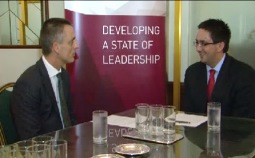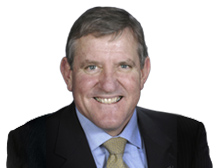Business leaders: Take a lead from the Leaders
By Mike Sullivan >>
JAMES PAULSEN has no illusions about how tough the Australian business market is right now.
“I think the business environment in South East Queensland is probably the most depressed I have seen in 16-18 years. It’s very segmented.” 
The founder and executive director of International Leaders – the collaborative business development organisation that has grown state-by-state and now country-by-county out of Queensland Leaders – gets his information straight from the business coal face. He is in contact, daily, with the most energetic and innovative business leaders in Australia across most industry sectors and company sizes.
“I think for existing businesses that have been around for a long time, a lot of them are tired,” Mr Paulsen said. “This GFC, in one form or another, has been going on for almost eight years so it is taking a toll.
“However, the excess has been taken out of the market, so we are starting to see an equilibrium come in with supply and demand. And I think for a lot of business owners, they always say it is darkest before the dawn, there might be another glitch or two, but fundamentally I am hoping we are near the bottom.
“From that perspective, if you can build a business in this market, then when the times are good it will be exceptional.”
Mr Paulsen said reports in recent months had been encouraging.
“Sydney is emerging and I think that is being driven by a bit more of a stable government in recent times, but moreso increased population,” Mr Paulsen mused. “Melbourne has this unexplainable confidence about it, considering that about 15 years ago it was the basket case of Australia.
“One of the biggest problems we are facing here in South East Queensland and perhaps more broadly across Queensland is an absolute lack of confidence. I would say Queensland has lost its mojo.”
The reasons are many and varied, but the challenge, he said, was to get that mojo back as quickly as possible. Jobs are primarily going to come from early stage, fast growth companies.
“The quickest way to employ people is about empowering those next stage companies,” Mr Paulsen said. “You don’t need to have a company, say, like Youi on the Sunshine Coast all of a sudden employing 2000 people – those sorts of things come across once in a while, like Virgin (establishing its headquarters in Brisbane).
“Governments make the mistake, I think, of buying in big employers and the net cost may or may not work. We have seen them buy call centres before and within three or four years they are shut down – they shed jobs.
“It annoys the local industry who are saying, why are you supporting someone else who has shown no interest here?
“The big opportunity I see is if these one or two people businesses just employ another person.”
Mr Paulsen said apart from an imperative to sell the brighter picture – in Queensland’s case the onset of the liquefied natural gas export boom and the rebound of tourism – government was largely irrelevant in turning the business environment around.
“Now I think business owners are quite sceptical of what government says. I think the time of having a PR flack pushing out good news stories is gone.” He advocated some practical assessment by government, rather than fairytale telling.
“There should be some factual analysis … embrace that … then it will filter down to the start-up stage and hopefully rebuild the state,” Mr Paulsen said. He noted that some of the best performing growth companies in the Leaders networks were those that were driven by passionate entrepreneurs.
“We’ve got companies like Nimble in the tech space and Corporate Travel Management and they are not hanging around a certain sector – the success behind those companies are the individuals (that run them),” he said. “They have a fire in the belly and they have got a focus on what they want to achieve.
“What such companies are looking for is access to the expertise and resources around them to achieve their goal.” That, of course, is where the Leaders network and support systems come in.
“We always say to companies, ‘work on your business not in your business’ and sometimes that transition is very difficult because they might be a 2-3 person business and they spend 15 hours a day just trying to build revenue,” Mr Paulsen said.
“At what stage do you get the opportunity to start looking strategically? The conundrum there is that until the company can look strategic, they are never going to get out of the hole they are in.”
Mr Paulsen identified two areas of opportunity for Queensland business at the moment.
“We have to look at innovation, we just have to do things differently: embrace technology, better systems, better services … just to create a point of difference,” he said.
“The second point that I think most companies miss is collaboration. No one person has all the skills to build a highly successful company; it is the input of the stakeholders, the external people who guide and provide the feedback for these people to make better decisions.”
HOW LEADERS LEAD
In recent months, Queensland Leaders has collaborated with leading organisations such as CSIRO, to give members access to its Mega Trends analysis, and also over many years with lawyers, accountants and other experts leading their fields.
“It’s great to get peer understanding on a decision, but it is also great to get understanding from a lawyer or an accountant or an adviser who has done that transactions 58 times,” Mr Paulsen said. That is the power of the Leaders networks. 
“I say make a strategic decision, but the more advice you get and the better researched you are, the better that decision is going to be.”
This is the crux of the Leaders formula for helping businesses to generate success. It provides a new way for government to assist the development of the companies that are going to create new jobs.
“We try to bring in a lot of hook ups of Federal Government, Local Government and State Government,” Mr Paulsen said. “Each have different things to contribute to private growth companies. Then we support those private growth companies with peer engagement.
“So the software firm can talk with the advanced manufacturing firm about business models or client retention. But then surround them with the expertise … so you have got access to the lawyers and the accountants and experts.
“I always use the example of MYOB or Microsoft – probably not necessarily the best products in the market, but they are market leaders because they got all the other factors right.”
Mr Paulsen describes the Leaders’ Industry Experts groups as “a better mousetrap”.
“With their expertise they can find points of differentiation and competitive advantage that is outside (a business leader’s) own product. The collaboration point – looking at ways that product can go into a whole different industry or a whole different application that no-one in their organisation would have thought about.”
The final piece of the Leaders puzzle is the Industry Partners group.
“That’s the big public companies, like your TechnologyOnes and your Corporate Travel Managements and such,” Mr Paulsen said. “The lessons they can teach – sometimes it’s very high level – but at the end of the day I think it is some of the most sound information we have received.”
Where the Leaders groups have clearly differentiated themselves from other business support organisations is in the motivation behind those involved.
“It’s an interesting psychology. The people we choose in the network are organisations that I think are very philanthropic and dedicated to working with growth companies. I don’t think we have anyone there with that rape and pillage mentality – they wouldn’t last very long,” Mr Paulsen said.
“We don’t deal with the top four or the top five legal and accounting firms and that’s because this is not their bread and butter. We deal with those organisations that live and breathe SME companies. I think because of that they have got both the experience and compassion to work with these people.”
SME: TOUGH GIG
James Paulsen, whose background is private equity and investment banking, has worked with the SME market for almost 20 years “and it is a very tough market to operate in”.
“Money is thin on the ground, there are so many distractions and there are so many issues facing these businesses. And their ability to focus sometimes wavers,” he said. “You have got to be as dedicated as they are to build the relationship.
For many years Queensland Leaders developed its successful Executive Series, which settled in the range of companies with an average turnover of the $40-$50 million mark. Mr Paulsen said it became clear there was a need to work with earlier stage companies.
“In July last year we started our Future Leaders series, where the average turnover (of the 12 companies involved) is about $1.2 million and these are the next generational companies,” he said. “Fast movers, they are trying to establish a solid foundation and a sustainable business. So many early stage businesses are focused on driving the revenue or focused on all the factors that don’t drive long-term success.
“For most of us in this world, you learn by your mistakes and I guess with the Leaders’ model it is about learning through other people’s experience. They come to an environment that has all this information at their disposal. They go through a structured process where they understand everything from the IP protection, the marketing, the strategy, the brand, the technology development as well as the protection and legal matters.
“For them it’s a practical MBA – I don’t like using that term – but it does take them through a logical purpose and a process that enables them to implement. They cannot just do everything at once because then they take their eye off the ball.”
In July Queensland Leaders launched the second Future Leaders series in alliance Brisbane Angels – and this series is focused on companies looking to acquire capital in the short term.
“Once you start to bring external investors into a business the dynamics change extraordinarily,” Mr Paulsen said. “For a lot of those businesses it is about them understanding how the game is played and what they need to do – and the expectations.”
Feedback had been that knowing how to raise capital and deal with investors as been transformative for the Future Leaders companies.
“I think a lot of companies who have raised funds, probably in hindsight, wouldn’t have done it,” Mr Paulsen said of outcomes he had seen over 25 years in the field. “Part of our process enables them to get that understanding. There are also a lot of companies who haven’t raised funds but if they understood the process probably would. Education plays a strong part.”
A crucial role Queensland Leaders is playing is in matching the various parties.
“The Brisbane Angels tell me there is no lack of capital out there,” he said. “The State Government who runs the Mentoring for Growth program tells me there is no lack of companies out there.
“We can see both sides and we see that they are really not communicating with each other.”
The experience of Queensland Leaders has borne this out.
“When we looked at expanding, we thought we’d have to go and raise capital,” Mr Paulsen said. “It was actually some of the lawyers through Leaders that came to us and helped us to restructure our licensing model that we didn’t have to go and raise funds. The funding required to set up different interstate models was actually sourced from the licensee and repaid back through licensee refunds.
“So there are a million and one ways to skin a cat and what a lot of businesses do is get a strategy in their minds but they don’t have the network around them to explore that strategy and have quite fruitful conversations about other ways of achieving that ultimate goal … without having to raise funds.
“One thing I’d say to other companies is seek as much feedback and advice and case studies as you can, because there are different ways to achieve things. Only so many transactions need capital, external equity. They are the ones where there is a strong reliance on intellectual property or technology development or brand or market development – and that money can multiply quite quickly with the value proposition. If you are just seeking funds to pay yourself next year and to develop a new product, then it is not going to work – you need to bail.”
He was particularly critical of the Silicon Valley-style capital raising hype that is so prevalent in the technology space.
“If you counted up all the businesses that had gone the Silicon Valley way against all the businesses who had tried to replicate that path, it is like winning the Lotto,” Mr Paulsen said.
“Certain people in industry try to create a hype around it. What it does is create a cloud for the entrepreneur and a false expectation for what is going to happen. The scary thing is, how many great technologies have been lost because so many people went down a particular path where the chances of success were minimal or nil anyway? How many of those have been lost instead of asking, well, if we don’t raise capital how can we get this product or service to the market, using working capital or other forms of capital?”
One area the Federal Government could modify for positive impact, given the changing nature of work and companies, Mr Paulsen said, was to add flexibility to the taxation system.
“I think the government needs to have a real strong look at successful models overseas. If every small business just employed another person this year, our unemployment rate would go down,” Mr Paulsen said.
“But what’s the incentive? What they are doing (SMEs) is they are working harder. That means they are not focusing on the strategy they are focusing on the operations. If they employed that person and started focusing on the business, they could actually probably create a good multiplier with the freedom they have to look at the bigger picture.”
In spite of all the barriers and challenges, Mr Paulsen remains an optimist about the capacity of Australians to create great businesses – he just stresses that entrepreneurs need to focus on the basics, such as reaching profitability early, the business’s cashflow dynamics and longer term sustainability, and not heading down alleyways that can prove to be dead ends “such as seeking government grants”.
“You always have a lot of energy coming through with new business owners and there’s that naivety that goes with it, I think, that is a bit of a foundation of success in Australia – that entrepreneurial get up and go.”
- Business Acumen subscribers can read extended and more detailed versions of articles featured in our SME Special Report – and a range of other selected stories not available to the general public – by signing in online. Subscribe to our full print and digital magazine service: it’s the best $99 your company will spend all year.
ends

 How to resolve AdBlock issue?
How to resolve AdBlock issue? 



